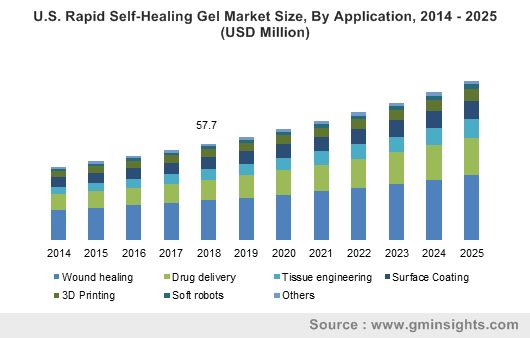North America rapid self-healing gel market to procure substantial proceeds by 2025, global industry to be characterized by highly innovative product advancements
Publisher : Fractovia | Published Date : 2019-05-24Request Sample
Rapid enhancement in the domain of wound healing has been the biggest contributor to the growth of rapid self-healing gel market over the last half a decade. Rapid self-healing gel is used extensively for an array of purposes including medical sutures, industrial sealants, 3D printing, tissue engineering, drug delivery, and self-healing plastics, due to its exceptional structural, mechanical, and rheological properties. Increasing medical expenditure and rising pervasiveness of several medical conditions is poised to offer lucrative growth opportunities to this industry. For instance, according to the National Health Expenditures 2017, U.S. healthcare spending augmented 3.9 percent to reach $3.5 trillion or USD 10,739 per person in 2017, whereas spending for dental services augmented 3.2 percent in 2017 to USD 129.1 billion.
U.S. Rapid Self-Healing Gel Market Size, By Application, 2014 - 2025 (USD Million)

Along with being a preferred choice for a slew of biomedical applications, these gels are also used for surface coating applications in the healthcare & electronics sector. Growing investment in R&D by top players of this business space, along with technological enhancements, would undoubtedly amplify the utilization of the rapid self-healing gel over the coming years. According to the latest research by Global Market Insights, rapid self-healing gel market is slated to surpass a market valuation of USD 310 million by 2025.
Illuminating the noteworthy developments in the rapid self-healing gel industry:
Adhesive self-healing gel for curing eye damage
Infections and injuries of the cornea are the leading cause of visual impairments worldwide, with corneal transplants being the most common treatment option. The University of California based in Los Angeles has recently disclosed that it has developed an adhesive gel which has the potential to improve the curing of the cornea. The gel can be applied post an injury, and carries the ability to reduce the need for corneal transplants and surgical procedures.
GelCORE, the biomaterial used in the gel, comprises a clear, viscous material that can be administered with a dropper or syringe. Upon application, the gel is allowed to get hard by exposing it to short bursts of visible blue light, so that it attains the transparency and density similar to the cornea. This newfangled biomaterial fulfills a major unfulfilled need in the field of cornea treatment.
The foremost advantage of this adhesive self-healing gel is that it completely integrates with the corneal tissue and seals defects seamlessly just like real cornea. The influx of such an innovative product is certain to augment the commercialization potential of rapid self-healing gel industry.
Japanese scientists create exceptional self-healing ion gel
Researchers at the University of Tokyo and Yokohama National University in Japan have developed an ion gel demonstrating exceptional strength and self-healing ability at ambient temperatures without using any exterior stimuli such as light or temperature. The ion gel dictates astounding rapid self-healing abilities at room temperature by restructuring hydrogen bonds at the injured surface. Ion based gels have gained immense popularity lately, owing to unique properties such as low evaporation tendency at room temperature, high thermal stability, and a high ionic conductivity.
Speaking of the real-world applications, the self-healing gel can be applied on wearable electronic devices which are often bent and stretched several times during the day. The self-healing properties of this gel will effectively fix damages and cracks caused due to the bending and stretching, as well as improve the gadget’s durability. Undeniably, a product of this caliber will enhance the competitiveness among leading players, augmenting the expansion of rapid self-healing gel market
North America – the powerhouse of rapid self-healing gel market in the future
Speaking of regional hierarchy, North America has emerged as a strong contender of the global rapid self-healing gel market accounting for a share of over forty percent in the overall industry in 2018, as per a report by Global market insights, Inc. Maintaining this momentum in the future, the North America rapid self-healing gel industry is projected to register a CAGR of 7 percent over 2019-2025.
The leading organizations impacting the growth of this regional fragment include Cytogel Pharma, Cardinal Health, and others that are increasingly investing in research and development, validating patent license agreements, and introducing novel products based on resins and polymers to support a broad range of applications.
Self-healing hydrogels have many varied industrial and biomedical applications, but the challenges for rapid self-healing gel industry are equally diverse. The future seems to be rather interesting for rapid self-healing gel market, with endless opportunities, as scientists are currently working on the 3D printability of this material, so as to create a fully transparent circuit board that can effectively serve in robotic applications. Not to mention, industry-wide research & development initiatives are looking to create a future where electronic devices can execute self-repair functions to decrease the amount of discarded electronic waste. In the coming years, it will be interesting to see how other novel applications of rapid self-healing gel spring up and prove beneficial worldwide.